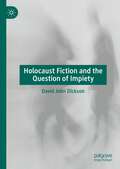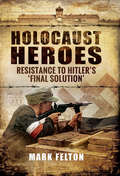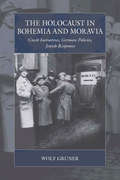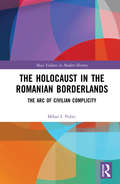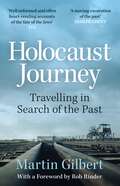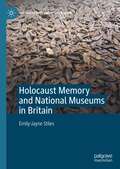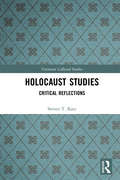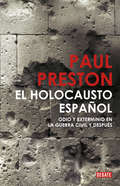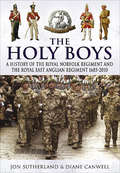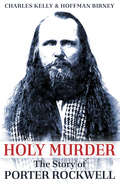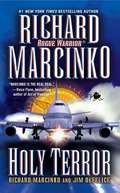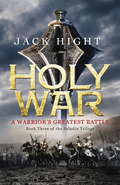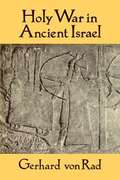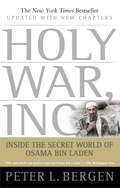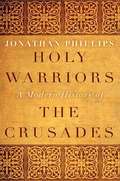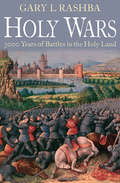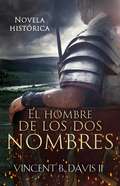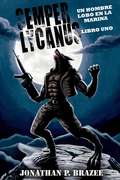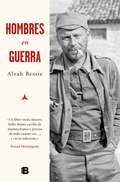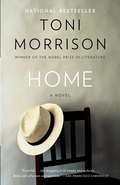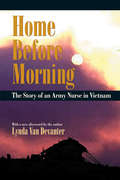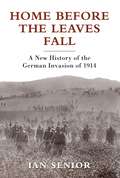- Table View
- List View
Holocaust Fiction and the Question of Impiety
by David John DicksonThis book discusses the issues underlying contemporary Holocaust fiction. Using Gillian Rose’s theory of Holocaust piety, it argues that, rather than enhancing our understanding of the Holocaust, contemporary fiction has instead become overly focused on gratuitous representations of bodies in pain. The book begins by discussing the locations and imagery which have come to define our understanding of the Holocaust, before then highlighting how this gradual simplification has led to an increasing sense of emotional distance from the historical past. Holocaust fiction, the book argues, attempts to close this emotional and temporal distance by creating an emotional connection to bodies in pain. Using different concepts relating to embodied experience – from Sonia Kruks’ notion of feeling-with to Alison Landsberg’s prosthetic memory – the book analyses several key examples of Holocaust literature and film to establish whether fiction still possesses the capacity to approach the Holocaust impiously.
Holocaust Heroes: Resistance to Hitler's 'Final Solution'
by Mark FeltonThis inspiring book examines the often incredible and nearly always tragic examples of Jewish resistance in ghettos and concentration camps during the Nazis ‘Final Solution. It shows that the Warsaw Uprising in Poland during April to May 1944 was not the only occasion of defiant opposition. Throughout the Nazis extermination programme Jews and other prisoners fought back against their murderers, often with stunning results. The Germans were nearly always taken by surprise by the sudden emergence of armed Jewish resistance and often paid dearly. This happened in ghettos and concentration campos (including Treblinka, Auschwitz, Syrels and Sobibor) throughout Poland and the Ukraine. Some Jews tried to stop the machinery of the Holocaust by rising up and destroying the gas chambers while others bravely tried to take over an extermination camp and escape en masse. In virtually every case the brave men and women who volunteered to fight back paid with their lives. Importantly these men and women are not just portrayed as victims but also as brave and resourceful fighters and resisters against their tragic fate. These are stories that are uplifting, inspiring and often profoundly moving.
The Holocaust in Bohemia and Moravia: Czech Initiatives, German Policies, Jewish Responses (War and Genocide #28)
by Wolf GrunerPrior to Hitler’s occupation, nearly 120,000 Jews inhabited the areas that would become the Protectorate of Bohemia and Moravia; by 1945, all but a handful had either escaped or been deported and murdered by the Nazis. This pioneering study gives a definitive account of the Holocaust as it was carried out in the region, detailing the German and Czech policies, including previously overlooked measures such as small-town ghettoization and forced labor, that shaped Jewish life. Drawing on extensive new evidence, Wolf Gruner demonstrates how the persecution of the Jews as well as their reactions and resistance efforts were the result of complex actions by German authorities in Prague and Berlin as well as the Czech government and local authorities.
The Holocaust in the Romanian Borderlands: The Arc of Civilian Complicity (Mass Violence in Modern History)
by Mihai I PoliecThis volume examines the changing role which ordinary members of society played in the state-sponsored persecution of the Jews in Bukovina and Bessarabia, both during the summer of 1941, when Romania joined the Nazi invasion of the Soviet Union, and beyond. It establishes different patterns of civilian complicity and discusses the significance of the phenomenon in the context of the exterminatory campaign pursued by the Romanian military authorities against the Jews living in the borderlands.
Holocaust Journey: Travelling In Search Of The Past
by Sir Martin GilbertIncludes a new foreword by Rob RinderWhat readers are saying about HOLOCAUST JOURNEY:'Brilliant ... A must read for everybody' ⭐⭐⭐⭐⭐'Devastating' ⭐⭐⭐⭐⭐'Fascinating, thought provoking and shocking' ⭐⭐⭐⭐⭐'Everybody should read this' ⭐⭐⭐⭐⭐'Informative and emotional' ⭐⭐⭐⭐⭐In June 1996 Martin Gilbert took a group of students on a two-week journey across middle-Europe which encompassed all the major places in the Holocaust - from Wannsee where the extermination of the Jews was decreed, to the camps themselves, via deserted Jewish communities and synagogues as well as the sites of the ghettos and deportation.'The achievement of Gilbert's HOLOCAUST JOURNEY is to reduce to comprehensible, human terms of the scale of the genocide that to many is still unimaginable' LITERARY REVIEW'Filled with short, well-informed and often heart-rending accounts of the fate of the Jews' TLS'HOLOCAUST JOURNEY travels along the tracks of a history we would rather forget to the sites of wartime horror, and is also a moving excavation of the past' INDEPENDENT
Holocaust Journey: Travelling In Search Of The Past
by Sir Martin GilbertIncludes a new foreword by Rob RinderWhat readers are saying about HOLOCAUST JOURNEY:'Brilliant ... A must read for everybody' ⭐⭐⭐⭐⭐'Devastating' ⭐⭐⭐⭐⭐'Fascinating, thought provoking and shocking' ⭐⭐⭐⭐⭐'Everybody should read this' ⭐⭐⭐⭐⭐'Informative and emotional' ⭐⭐⭐⭐⭐In June 1996 Martin Gilbert took a group of students on a two-week journey across middle-Europe which encompassed all the major places in the Holocaust - from Wannsee where the extermination of the Jews was decreed, to the camps themselves, via deserted Jewish communities and synagogues as well as the sites of the ghettos and deportation.'The achievement of Gilbert's HOLOCAUST JOURNEY is to reduce to comprehensible, human terms of the scale of the genocide that to many is still unimaginable' LITERARY REVIEW'Filled with short, well-informed and often heart-rending accounts of the fate of the Jews' TLS'HOLOCAUST JOURNEY travels along the tracks of a history we would rather forget to the sites of wartime horror, and is also a moving excavation of the past' INDEPENDENT
Holocaust Memory and National Museums in Britain (The Holocaust and its Contexts)
by Emily-Jayne StilesThis book explores the Holocaust exhibition opened within the Imperial War Museum (IWM) in 2000; setting out the long and often contentious debates surrounding the conception, design, and finally the opening of an important exhibition within a national museum in Britain. It considers a process of memory-making through an assessment of Holocaust photographs, material culture, and survivor testimonies; exploring theories of cultural memory as they apply to the national museum context. Anchored in time and place, the Holocaust exhibition within Britain’s national museum of war is influenced by, and reflects, an international rise in Holocaust consciousness in the 1990s. This book considers the construction of Holocaust memory in 1990s Britain, providing a foundation for understanding current and future national memory projects. Through all aspects of the display, the Holocaust is presented as meaningful in terms of what it says about Nazism and what this, in turn, says about Britishness. From the original debates surrounding the inclusion of a Holocaust gallery at the IWM, to the acquisition of Holocaust artefacts that could act as 'concrete evidence' of Nazi barbarity and criminality, the Holocaust reaffirms an image of Britain that avoids critical self-reflection despite raising uncomfortably close questions. The various display elements are brought together to consider multiple strands of the Holocaust story as it is told by national museums in Britain.
Holocaust Studies: Critical Reflections (Variorum Collected Studies)
by Steven T. KatzThe great majority of Holocaust scholarship concentrates heavily, if not almost completely, on the Final Solution from the German side. The distinctive feature of this book, both individually and as a collection, is its concentration on the Holocaust from a Judeo-centric point of view. The present essays make a unique contribution by exploring issues such as: the effect of events specifically on Jewish women and children; the character of the Nazi policy of slave labor in as much as this essential program resulted in different treatment with regard to Jews as compared to other workers; how the destruction of European Jewry has been responded to by Jewish thinkers; and how Jewish values, such as the well-known principle that "all Jews are responsible for each other," were exemplified and lived out during the war. The collection also includes an essay on Elie Wiesel, and another that explores the much discussed, very controversial issue of Jewish resistance, as well as several essays on philosophical and comparative issues raised by the Shoah.
El holocausto español: Odio y exterminio en la Guerra Civil y después
by Paul PrestonLa represión durante la guerra y en la inmediata posguerra contada por el más prestigioso hispanista de la actualidad. «Durante la Guerra Civil española, cerca de 200.000 hombres y mujeres fueron asesinados lejos del frente, ejecutados extrajudicialmente o tras precarios procesos legales, y al menos 300.000 hombres perdieron la vida en los frentes de batalla. Además, un número desconocido de hombres, mujeres y niños fueron víctimas de los bombardeos y los éxodos que siguieron a la ocupación del territorio por parte de las fuerzas militares de Franco. En el conjunto de España, tras la victoria definitiva de los rebeldes a finales de marzo de 1939, alrededor de 20.000 republicanos fueron ejecutados. Muchos más murieron de hambre y enfermedades en las prisiones y los campos de concentración donde se hacinaban en condiciones infrahumanas. Otros sucumbieron a las condiciones esclavistas de los batallones de trabajo. A más de medio millón de refugiados no les quedó otra salida que el exilio, y muchos perecieron en los campos de internamiento franceses. Varios miles acabaron en los campos de exterminio nazis. »Todo ello constituye lo que a mi juicio puede llamarse el «holocausto español». El propósito de este libro es mostrar, en la medida de lo posible, lo que aconteció a la población civil y desentrañar los porqués.»Paul Preston Reseña:«Debiera ser de lectura obligada no solo para los interesados por nuestro pasado sino, y sobre todo, para los educadores de las generaciones futuras.»Ángel Viñas, Babelia, El País
The Holy Boys: A History of the Royal Norfolk Regiment and the Royal East Anglian Regiment 1685-2010
by Diane CanwellThe Royal Norfolk Regiment is one of the oldest and most distinguished fighting forces in the British army. Its line of descent can be traced back for over three centuries, all the way from modern Afghanistan to Monmouths rebellion in 1685.Throughout these years, and many campaigns, the regiment has maintained a marked local loyalty and tradition which remain strong today. This sense of local identity is celebrated by Jon Sutherland and Diane Canwell in this highly illustrated history of the regiment which describes, in graphic detail, the exploits of Norfolk soldiers who have made a notable contribution to the British army in every major conflict the country has faced.
Holy Murder: The Story of Porter Rockwell
by Charles Kelly Birney HoffmanHoly Murder, first published in 1934, is a fascinating, controversial look at the “Avenging Angel” of the Mormon Church, Porter Rockwell. The authors trace the violent history of the Mormon Church beginning with its origins in New York and Illinois, to the flight of its members and their settlement near the Great Salt Lake. Citing numerous sources and interviewing witnesses and descendants, the exploits of Rockwell are detailed to form a picture of a man on the one hand kind to children and his friends, while on the other capable of the most grisly murders of perceived enemies of the church. Although open to criticism for its anti-Mormon bias, attempting to accurately portray Rockwell is difficult as he did not keep a personal diary and many of his activities were shrouded in secrecy. Included are 12 pages of illustrations.
Holy Terror (Rogue Warrior #13)
by Richard MarcinkoNo one has ever accused Richard Marcinko -- aka Rogue Warrior® -- of being an altar boy, but in the latest installment of his bestselling series, Demo Dick finds himself darkening the aisles of St. Peter's Basilica in Vatican City, tracking a group of terrorists who want to turn the world's largest Catholic church into the world's biggest Roman candle. A trip to Italy for Dick Marcinko turns into more than pasta and gondola rides. Nothing and no one is sacred as Marcinko sprays irreverent asides, targeting everything from antiterror wannabes to the nuns who taught him in parochial school. Called "the real deal" by Vince Flynn, the bestselling author of Memorial Day, Marcinko entertains, informs, and even finds time to genuflect in his new book. Visiting a NATO conference in Rome, Demo Dick blisters bureaucratic ears with a speech about Europe's vulnerabilities and the need to get serious about terrorism. He caps off his talk with an impromptu demonstration of the threat, unmasking a plot to kill the conferees seconds before it begins -- and just in time to play volleyball with a live hand grenade. The action ratchets up from there as the former SEAL commander is shanghaied to Sicily to help investigate the attempted theft of nukes from a U.S. base. Is the Mafia involved? Or is this the work of Saladin, a shadowy extremist trying to step into bin Laden's shoes? A high body count lends credence to both theories, but before Demo Dick can untangle the plot, his firm is hired to track down "shrinkage" in a courier operation in Asia. Since said shrinkage involves data and currency worth hundreds of millions of dollars, Demo Dick anticipates a Rogue-sized finder's fee. But he soon discovers the job is a trap. Lured to a cave filled with outrageously hungry tigers in the Thailand jungle, Demo Dick sucks cat breath before being saved by the beautiful if prickly Trace Dahlgren and veteran Rogue sideman Al "Doc" Tremblay. Marcinko has only escaped the frying pan for the fire; he rides a hijacked jet back to Italy, where Saladin plans to wrap up the plot's loose ends in a bonfire at the center of the Eternal City. In Holy Terror, Marcinko mixes his trademark wit and wisdom with nonstop action in a romp across Europe and Asia.
Holy War: Book Three of the Saladin Trilogy
by Jack HightIn HOLY WAR, the final book of the Saladin Trilogy, telling the story of the legendary war leader who united Arabia, Saladin recaptures Jerusalem from the Crusaders, and prepares for his ultimate battle against Richard the Lionheart. A full-blooded historical adventure novel for all fans of Conn Iggulden, Bernard Cornwell, Anthony Riches, Ben Kane, Robyn Young and Simon Scarrow.While Saladin ruthlessly sets about uniting the whole of Arabia under his rule, the Kingdom of Jerusalem is torn apart by treachery and intrigue, and when the murderous knight Reynald of Chatillon raids a caravan heading from Damascus to Mecca and rapes Saladin's sister, the scene is set for war.In June 1187, Saladin marches into the Kingdom with an army of over 24,000 and imposes a crushing defeat on the Crusader forces at the Horns of Hattin. It is only a matter of time before he marches on a panicked and demoralized Jerusalem.But what about Saladin's longtime ally, the Saxon knight John of Tatewic? In the face of annihilation, is he friend or foe? It will take all John's knowledge of the man he calls his brother to negotiate a peaceful fate for Jerusalem - but this is not the end of the story. For in England the soon-to-be crowned King Richard has pledged revenge and a new Crusade . . .
Holy War in Ancient Israel
by Gerhard Von RadTranslation of Der Heilige Krieg im alten Israel from German into English.
Holy War, Inc.: Inside the Secret World of Osama Bin Laden
by Peter L. BergenOn September 11, 2001, the world in which we live was changed forever. The twin towers of the World Trade Center came crashing down, one side of the Pentagon burst into flame, and more than six thousand men, women, and children lost their lives in the most deadly terrorist attack on American soil. As shocking as it was, it had been long in the making: The assault was the most sophisticated and horrifying in a series of operations masterminded by Osama bin Laden and his Jihad group -- an organization that CNN's terrorism analyst Peter Bergen calls Holy War, Inc. One of only a handful of Western journalists to have interviewed the world's most wanted man face to face, Peter Bergen has produced the definitive book on the Jihadist network that operates globally and in secrecy. In the course of four years of investigative reporting, he has interviewed scores of insiders -- from bin Laden associates and family members to Taliban leaders to CIA officials -- and traveled to Afghanistan, Yemen, Egypt, Pakistan, and the United Kingdom to learn the truth about bin Laden's al Queda organization and his mission. Immense in scope and unnerving in its findings,Holy War, Inc. reveals:How bin Laden lives, travels, and communicates with his "cells. " How his role in the crushing defeat of the Soviet Union in Afghanistan made him a hero to Muslims all over the world -- and equipped him to endure a long and bloody siege. How the CIA ended up funding -- to the tune of three billion dollars -- radical, anti-American Afghan groups allied to bin Laden. How the attacks that foreshadowed the destruction of the World Trade Center -- among them the bombings of the American embassies in Africa and the warship USSColein Yemen -- were planned and executed. The dimensions of bin Laden's personal fortune, and why freezing his assets is both futile and nearly impossible. The ideology of bin Laden's number two, the man who has influenced him most profoundly in his holy war -- the Egyptian Ayman al Zawahiri. What we can expect from Islamist extremists in the future. Above all, Peter Bergen helps us to see bin Laden's organization in a radically new light: as a veritable corporation that has exploited twenty-first-century communications and weapons technologies in the service of a medieval reading of the Koran and holy war. Holy War, Inc. is essential reading for anyone trying to understand tomorrow's terrorist threats and the militant Islamist movements that could determine the fate of governments -- and human lives -- the world over. Both author and publisher will donate a portion of the proceeds from this book to United Way's September 11th Fund for the relief of victims of the World Trade Center attacks.
Holy Warriors: A Modern History of the Crusades
by Jonathan PhillipsWhen George Bush inaugurated the War on Terror in 2001, he referred to it as a 'crusade'. A medieval Crusade could be defined thus: a holy war initiated by the Pope on God's behalf in which the participants took the cross and received remission for their sins. The First Crusade, launched in 1095, ushered in a period of almost 200 years of Christian rule in the Levant, yet over time crusades were directed against a variety of opponents, not just Muslims in the Middle East: against Cathar heretics, political enemies of the papacy, the Mongols, pagan tribes of northern Europe, and the Ottoman Turks, well into the sixteenth century. While the notion of fighting for one's faith fell into disrepute during the Enlightenment, whose proponents viewed the idea as primitive and barbaric, in reality the cultural engines of romanticism and orientalism gave the memory of the crusades a significant boost in the nineteenth century. The notion of moral right buttressed by royal authority helped to drive the expansion of European power through imperialism and colonialism, and in both World Wars the theme of crusading was used as a call to arms. As Jonathan Philips demonstrates in this timely and revealing study, crusading has proven to be a remarkably adaptable and long-lasting phenomenon, embedded in the actions and consciousness of the West for centuries. Unlike other histories of the Crusades this one firstly comes up to the present day and secondly, avoids a chronological slog through the whole movement. Instead it drills a series of bore holes into the key aspects and moments: The First Crusade, Richard the Lionheart and Saladin, the Templars, the Jihad, etc. Thirdly, it is incredibly vivid and accessible - we hear the swords, taste the food, see the sights and feel the heat.
Holy Wars: 3000 Years of Battles in the Holy Land
by Gary L. Rashba&“A compelling tale of how this spiritually and politically charged area of the globe has long been a place of pivotal battles&” (Library Journal). Today&’s Arab-Israeli conflict is merely the latest iteration of an unending history of violence in the Holy Land—a region that is unsurpassed as witness to a kaleidoscopic military history involving forces from across the world and throughout the millennia. Holy Wars describes three thousand years of war in the Holy Land with the unique approach of focusing on pivotal battles or campaigns, beginning with the Israelites&’ capture of Jericho and ending with Israel&’s last full-fledged assault against Lebanon. Its chapters stop along the way to examine key battles fought by the Philistines, Assyrians, Greeks, Romans, Arabs, Crusaders, and Mamluks—the latter clash, at Ayn Jalut, comprising the first time the Mongols suffered a decisive defeat. The modern era saw the rise of the Ottomans and an incursion by Napoleon, who only found bloody stalemate outside the walls of Akko. The Holy Land became a battlefield again in World War I when the British fought the Turks. The nation of Israel was forged in conflict during its 1948 War of Independence, and subsequently found itself in desperate combat, often against great odds, in 1956 and 1967, and again in 1973, when it was surprised by a massive two-pronged assault. By focusing on the climax of each conflict, while carefully setting each stage, Holy Wars examines an extraordinary breadth of military history—spanning in one volume the evolution of warfare over the centuries, as well as the enduring status of the Holy Land as a battleground.
El hombre de los dos nombres
by Vincent B. Davis IIRoma, 107 AC. Quinto Sertorio acaba de perder a su padre y podría perder también su hogar. Cuando su aldea rural pierde su estatus político, debe abandonar a su familia para garantizar la supervivencia y protección de su aldea desde el interior del despiadado gobierno. Mientras se convierte de campesino en político, se verá enredado en medio de una amarga guerra política... A medida que Quinto lucha para ganarse la ayuda que tan desesperadamente necesita su aldea, conoce a Cayo Mario -el tío de Julio Cesar. Pero, con cada día que pasa en la implacable Ciudad Eterna, el riesgo para su familia y su propia vida es aún mayor. En esa cruel batalla moral, ¿se perderá Quinto a sí mismo y a aquellos a los que ama? El hombre de los dos nombres es el primer libro de la serie de ficción histórica sobre Sertorio. Si le gustan las ambiciones heróicas, los ambientes históricos exhaustivamente investigados y la corrupción romana... le encantará esta poderosa historia de Vincent B. Davis II.
Un Hombre Lobo en la Marina
by Jonathan P. Brazee Alfonso ColmenaresEl soldado de primera clase Aiden Kaas se ha alistado en los marines por todas las razones equivocadas. Ahora enviado a Irak a la edad de 19 años, lo único que quiere poner en su tiempo y cumplir su alistamiento. Sin embargo, después de haber sido mordido por un muyahidín aparentemente rabiosos, se encuentra que sufre de una extraña enfermedad, que tiene consecuencias más allá de sus fantasías más salvajes. A medida que la enfermedad hace estragos en su cuerpo y lo expone a peligros mucho más oscuro que el combate activo, Aiden descubre lo que significa la mayoría de edad, y la forma en que debe enfrentarse con lo que se ha convertido en... ADVERTENCIA: Este libro contiene escenas de violencia extrema y una de las escenas es de contenido sexual explícito.
Hombres en guerra
by Alvah BessieLa obra maestra olvidada sobre la guerra civil española que fascinó a Ernest Hemingway. Hombres en guerra es un clásico que habla de soldados en la línea de fuego, y uno de los mejores testimonios jamás escritos sobre cualquier guerra. Su autor, Alvah Bessie, fue un escritor y periodista estadounidense que en 1938 combatió en la guerra civil española como voluntario de la Brigada Lincoln. Al volver a su país convirtió los cuadernos que había escrito durante la contienda en la base de este libro, que fue publicado en inglés en 1939 -gracias al apoyo de Ernest Hemingway-, coincidiendo con la invasión de Polonia por parte de la Alemania nazi. Pronto Bessie se convirtió en un reconocido guionista de la Warner Brothers. Sin embargo, en 1950, tras ser acusado por el macartismo de pertenecer al Partido Comunista, fue uno de los Diez de Hollywood, el grupo de personas obligadas a abandonar la industria cinematográfica. Estamos, pues, ante una obra de no ficción que posee un alto valor histórico y literario. En ella Alvah Bessie narra su llegada a España, su incorporación a la Brigada Lincoln, su adiestramiento y su participación en la batalla del Ebro; comparte con nosotros sus marchas nocturnas hasta la primera línea de fuego y los momentos de intimidad... Y al hacerlo nos ofrece un testimonio, entrañable y profundamente humano, de aquellos hombres y mujeres que vinieron de todos los rincones del mundo para luchar por una misma causa.
Home: A novel (Vintage International)
by Toni MorrisonThe latest novel from Nobel Prize winner Toni Morrison.An angry and self-loathing veteran of the Korean War, Frank Money finds himself back in racist America after enduring trauma on the front lines that left him with more than just physical scars. His home--and himself in it--may no longer be as he remembers it, but Frank is shocked out of his crippling apathy by the need to rescue his medically abused younger sister and take her back to the small Georgia town they come from, which he's hated all his life. As Frank revisits the memories from childhood and the war that leave him questioning his sense of self, he discovers a profound courage he thought he could never possess again. A deeply moving novel about an apparently defeated man finding his manhood--and his home.This eBook edition includes a Reading Group Guide.
Home Before Morning: The Story of an Army Nurse in Vietnam
by Lynda Van Devanter Christopher MorganLynda Van Devanter was the girl next door, the cheerleader who went to Catholic schools, enjoyed sports, and got along well with her four sisters and parents. After high school she attended nursing school and then did something that would shatter her secure world for the rest of her life: in 1969, she joined the army and was shipped to Vietnam. When she arrived in Vietnam her idealistic view of the war vanished quickly. She worked long and arduous hours in cramped, ill-equipped, understaffed operating rooms. She saw friends die. Witnessing a war close-up, operating on soldiers and civilians whose injuries were catastrophic, she found the very foundations of her thinking changing daily. <P><P> After one traumatic year, she came home, a Vietnam veteran. Coming home was nearly as devastating as the time she spent in Asia. Nothing was the same ― including Lynda herself. Viewed by many as a murderer instead of a healer, she felt isolated and angry. The anger turned to depression; like many other Vietnam veterans she suffered from delayed stress syndrome. Working in hospitals brought back chilling scenes of hopelessly wounded soldiers. A marriage ended in divorce. The war that was fought physically halfway around the world had become a personal, internal battle.<P> Home before Morning is the story of a woman whose courage, stamina, and personal history make this a compelling autobiography. It is also the saga of others who went to war to aid the wounded and came back wounded ― physically and emotionally ― themselves. And, it is the true story of one person's triumphs: her understanding of, and coming to terms with, her destiny.
Home before Morning: The Story of an Army Nurse in Vietnam
by Lynda van Van DevanterLynda Van Devanter was the girl next door, the cheerleader who went to Catholic schools, enjoyed sports, and got along well with her four sisters and parents. After high school she attended nursing school and then did something that would shatter her secure world for the rest of her life: in 1969, she joined the army and was shipped to Vietnam. When she arrived in Vietnam her idealistic view of the war vanished quickly. She worked long and arduous hours in cramped, ill-equipped, understaffed operating rooms. She saw friends die. Witnessing a war close-up, operating on soldiers and civilians whose injuries were catastrophic, she found the very foundations of her thinking changing daily. After one traumatic year, she came home, a Vietnam veteran. Coming home was nearly as devastating as the time she spent in Asia. Nothing was the same -- including Lynda herself. Viewed by many as a murderer instead of a healer, she felt isolated and angry. The anger turned to depression; like many other Vietnam veterans she suffered from delayed stress syndrome. Working in hospitals brought back chilling scenes of hopelessly wounded soldiers. A marriage ended in divorce. The war that was fought physically halfway around the world had become a personal, internal battle.Home before Morning is the story of a woman whose courage, stamina, and personal history make this a compelling autobiography. It is also the saga of others who went to war to aid the wounded and came back wounded -- physically and emotionally -- themselves. And, it is the true story of one person's triumphs: her understanding of, and coming to terms with, her destiny.
Home Before the Leaves Fall
by Ian SeniorThe German invasion of France and Belgium in August 1914 came within an ace of defeating the French armies, capturing Paris, and ending the First World War before the autumn leaves had fallen. But the German armies failed to score the knock-out blow they had planned. The war would drag on for four years of unprecedented slaughter. There are many accounts of 1914 from the British point of view. The achievements of the British Expeditionary Force were the stuff of legend, but in reality there were only four divisions in the field; the French and Germans had more than 60 each. The real story of the battle can only be told by an author with the skill to mine the extensive German and French archives. Ian Senior does this with consummate skill, weaving together strategic analysis with diary entries and interview transcripts from the soldiers on the ground to create a remarkable new history. In addition, all previous classic histories on the subject either focus virtually exclusively on the British experiences or are now very out-of-date such as Barbara Tuchman's Guns of August (1962) or Sewell Tyng's Campaign of the Marne (1935).Supported by up numerous sketch maps, extensive archival research and poignant first-hand accounts, Home before the leaves fall is an accessible, narrative account of the German invasion that came within an ace of victory, that long hot summer.
